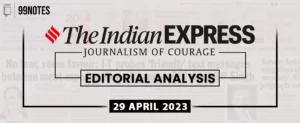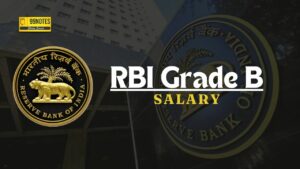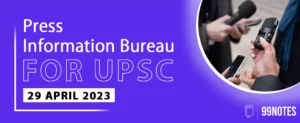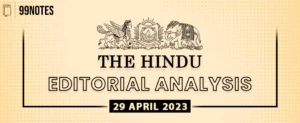30 April 2024 : Indian Express Editorial Analysis
Indian Express Editorial Analysis
30-April-2024
1. Mind the gap
| Topic: GS2 – Governance – Government policies – Interventions for development in various sectors
This topic is relevant for both Prelims and Mains in the context of understanding the challenges and evolution of electoral processes in India. |
| Context: |
|
Evolution of the Model Code of Conduct:
- The article transitions to a historical overview of the MCC’s development, tracing its origins from a rudimentary set of guidelines in 1960 to its refinement and expansion over subsequent decades.
- It emphasizes the MCC’s role in setting behavioral standards for political parties, candidates, and electoral authorities to uphold the integrity of the democratic process.
Challenges to the MCC’s Efficacy:
- However, despite its evolution, the MCC faces formidable challenges in contemporary politics.
- Violations are widespread, with political leaders resorting to prestige, firepower, and demagoguery to circumvent its provisions.
- The article underscores the diminishing effectiveness of the MCC in curbing malpractices, particularly in the face of evolving technologies and changing political dynamics.
Call for Reform:
- Recognizing the shortcomings of the current framework, the article advocates for a remodeling of the MCC to address its deficiencies.
- It proposes imposing more stringent and transparent penalties for violations, particularly targeting egregious offenses such as hate speech and inducement of voters.
- The article underscores the need for a fair and predictable enforcement mechanism to restore decorum and discipline in public discourse.
Enhanced Enforcement and Accountability Measures:
- To bolster the MCC’s enforcement, the article suggests streamlining procedures for handling violations and ensuring swift punitive action within a specified timeframe.
- It calls for greater transparency through public disclosure of reported violations and their resolutions.
- Additionally, it recommends integrating legal enforcement mechanisms to complement the EC’s actions, thereby holding violators accountable under existing laws.
Emphasis on Leadership Integrity:
- Ultimately, the article contends that while regulatory frameworks like the MCC are essential, true accountability lies in the character and conduct of political leaders.
- It underscores the importance of ethical leadership in fostering public trust and confidence in the electoral process, transcending the limitations of regulatory codes.
Conclusion:
- The article highlights the necessity for reforming the Model Code of Conduct (MCC) to address the shortcomings in its enforcement and to restore integrity to the electoral process.
- It emphasizes the need for more stringent penalties for violations, streamlined procedures, and greater transparency.
- Ultimately, the focus is on fostering ethical leadership and public trust in electoral governance.
| About MCC |
What is MCC ?:
|
| PYQ: Discuss the role of the Election Commission of India in the light of the evolution of the Model Code of Conduct. (UPSC CSE (M) GS-2 2022) |
| Practice Question: How has the evolution and contemporary challenges of the Model Code of Conduct (MCC) in India’s electoral process highlighted the necessity for reform, and what measures are proposed to enhance its effectiveness and integrity? (250 words/15 m) |
2. Mom, baby and us
| Topic: GS1 – Society – Social empowerment
GS2 – Governance- Issues arising out of their design & implementation. This topic is relevant for both Prelims and Mains in the context of understanding the societal norms and policies surrounding childcare responsibilities which provides insights into broader gender dynamics and social structures. |
| Context: |
|
Maternal Primacy in Child Rearing:
- In India, as in many other parts of the world, the primary responsibility for raising children until adulthood typically falls on mothers.
- This societal norm is reinforced by policies such as the Central Government’s Child Care Leave (CCL) policy, which provides paid leave exclusively to female employees for up to 730 days to care for children under 18 years, in addition to maternity leave.
Gendered Policy and Practical Realities:
- The explicit targeting of female employees for CCL reflects the acknowledgment of mothers’ predominant role in child-rearing, particularly beyond the initial maternity period.
- However, the eligibility of men for CCL is limited to single fathers, reflecting the entrenched gendered norms in caregiving responsibilities.
Balancing Equity and Practicality:
- While justifying the gendered nature of the CCL policy on pragmatic grounds, the passage raises questions about its reinforcement of inequitable norms.
- There is a genuine concern that offering CCL to fathers may not result in their active participation in childcare duties, potentially undermining the purpose of the policy.
Legal Protections and Enforcement:
- The Supreme Court’s intervention in cases of denial of CCL underscores the importance of recognizing working women’s constitutional rights.
- However, the article highlights discrepancies in the application of such policies between government and private sectors and questions the feasibility of implementation, especially in smaller establishments.
Limited Coverage and Potential Biases:
- Pro-women laws like CCL and maternity leave primarily benefit a small minority of employed women, leaving out the vast majority working in smaller establishments.
- Moreover, research suggests that in larger establishments where these laws are applicable, they may exacerbate employer bias against women in the short run.
Moving Towards Equity in Childcare:
- Despite these challenges, the article advocates for a broader approach to addressing the childcare burden, emphasizing the need for recognition, reduction, and redistribution of childcare responsibilities.
- It calls for investments in the care economy to ensure the realization of mothers’ constitutional rights and acknowledges childcare as a societal need.
Conclusion:
- The article underscores the complexities inherent in addressing the gendered division of childcare responsibilities and the limitations of existing policies in achieving equity.
- It advocates for a multifaceted approach that involves legal protections, societal recognition, and practical measures to redistribute caregiving responsibilities and invest in the care economy.
| Working Women & Child Care |
| What are the issues faced by working women in India with regards to child care?
1. Childcare Burden on Working women– Working women in India have to single-handedly manage the triple burden of housework, child care work and paid work. As per the Time Use Survey of India, 2019, Indian men spend 173 minutes compared to 433 minutes spent by women for unpaid domestic and care work. 2. Marriage penalties and motherhood penalties– Working women face ‘marriage penalties’ and ‘motherhood penalties’ due to their temporary forced withdrawal from workforce due to motherhood and childcare services. 3. Lack of implementation of Labour codes providing creche facilities– The new labour codes provide for the paid maternity benefits for childcare and mandate crèches on worksites. However, as the Annual Reports of the Ministry of Labour and Employment, these codes have been rarely implemented. 4. High degree of informalization– According to a 2018 study by the International Labour Organisation (ILO), more than 95% of India’s working women are informal workers. The absence of social security net, like paid leaves for Child care, in the informal sector discourages women from participating in the labour force. 5. Challenges with National Crèches Scheme– The scheme suffers from the challenges of underfunding, its limited reach and usage. What are the advantages of providing childcare leaves? 1. Economic Boost– According to the IMF, gender parity in the workforce can improve India’s GDP by 27%. A decrease in women’s unpaid care work is related to a 10-percentage point increase in women’s labour force participation rate. 2. Tackling poverty– It helps to tackle the phenomenon of feminisation of poverty, which is a result of highly informalised work performed by women. 3. Improvement in Social Indicators– Encouraging more women to enter the formal workforce will improve indicators like Infant Mortality Rate (IMR), Maternal Mortality Rate (MMR). 4. Self Confidence and Dignity– Financial independence enables women to play a greater role in decision-making like family planning. |
| Practice Question: Analyzing the gendered division of childcare responsibilities in India, with a focus on the Central Government’s Child Care Leave (CCL) policy, discuss its implications for working women, societal norms, and policy implementation challenges. How can equitable solutions be pursued to address the burden of childcare and promote gender equality in the workforce? (250 words/15 m) |
For Enquiry

30 April 2024 : Indian Express Editorial Analysis

RBI Grade B Salary- In Hand Salary, Grade Pay, Job Profile, Perks & Allowances

29 April 2024 : Daily Current Affairs Quiz

29 April 2024 : Daily Answer Writing

29 April 2024 : PIB Summary for UPSC

29 April 2024 : Daily Current Affairs

29 April 2024 : The Hindu Editorial Notes PDF

29 April 2024 : Indian Express Editorial Analysis

Sub Inspector Salary per month in India- Check other Perks & Allowance also

27 April 2024 : Daily Current Affairs Quiz
April 2024 Indian Express 30 April 2024 : Indian Express Editorial Analysis Indian Express Editorial Analysis
30-April-2024
1. Mind the gap
Topic: GS2 – Governance – Government…
Blogs Upsc RBI Grade B Salary- In Hand Salary, Grade Pay, Job Profile, Perks & Allowances RBI Grade B Salary- The starting salary of an RBI Grade B officer in India ranges from around INR 68,410…
Daily Quiz 29 April 2024 : Daily Current Affairs Quiz 29- April 2024 : Daily Quiz…
mains answer writing 29 April 2024 : Daily Answer Writing Mains Answer Writing
29-April-2024
Q1) Why are TOP (tomato, onion, potato) crops susceptible to large…
April 2024 PIB 29 April 2024 : PIB Summary for UPSC PIB Summary for UPSC
29-April-2024
1. Mines Ministry to Hold Two-day Critical Minerals Summit from Tomorrow
Topic:…
April 2024 Daily Current Affairs 29 April 2024 : Daily Current Affairs Daily Current Affairs
29-April -2024- Top News of the Day
1. India’s imports from China rise to $101…
April 2024 The Hindu Editorial 29 April 2024 : The Hindu Editorial Notes PDF The Hindu EDITORIAL
29-April-2024
1. Inequality can no longer be ignored
Topic: GS2 – Social Justice,…
April 2024 Indian Express 29 April 2024 : Indian Express Editorial Analysis Indian Express Editorial Analysis
29-April-2024
1. FOR FUTURE READY SENIORS
Topic: GS2 – Social Justice…
Blogs Upsc Sub Inspector Salary per month in India- Check other Perks & Allowance also Sub Inspector Salary – The starting salary of a police sub-inspector in India can vary from state…
Daily Quiz 27 April 2024 : Daily Current Affairs Quiz 27- April 2024 : Daily Quiz…



